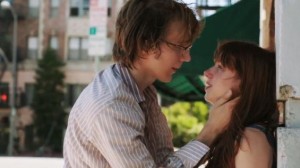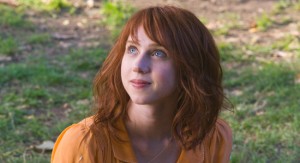Gender and Authorship in Ruby Sparks
 A promotional emphasis has been placed on the real-life couples involved in Ruby Sparks; Zoe Kazan wrote the screenplay to star herself and Paul Dano, and the film was directed by Jonathan Dayton and Valerie Faris. This background encourages the viewer to watch the film, which is rooted in the Pygmalion myth, as an allegory about intimate relationships. Calvin Weir-Fields (Dano), a once-successful author, begins a novel about his literal and metaphorical dream girl (Kazan) that somehow calls her into being. As an indie romance, the premise asks the viewer to think about what it would mean to be able to create the perfect partner. Would it be ideal to date someone who is a part of yourself, who shares your mind because he or she literally came from you? Beyond these implications, the film is distinctly relevant to longstanding discussions in media studies about the gendered nature of representations and authorship. The majority of American films are written by men, and female characters are thus manifestations of how men imagine women to be. As Ruby Sparks progresses, it questions limited and unrealistic representations of women, as well as the familiar tropes of the romantic comedy.
A promotional emphasis has been placed on the real-life couples involved in Ruby Sparks; Zoe Kazan wrote the screenplay to star herself and Paul Dano, and the film was directed by Jonathan Dayton and Valerie Faris. This background encourages the viewer to watch the film, which is rooted in the Pygmalion myth, as an allegory about intimate relationships. Calvin Weir-Fields (Dano), a once-successful author, begins a novel about his literal and metaphorical dream girl (Kazan) that somehow calls her into being. As an indie romance, the premise asks the viewer to think about what it would mean to be able to create the perfect partner. Would it be ideal to date someone who is a part of yourself, who shares your mind because he or she literally came from you? Beyond these implications, the film is distinctly relevant to longstanding discussions in media studies about the gendered nature of representations and authorship. The majority of American films are written by men, and female characters are thus manifestations of how men imagine women to be. As Ruby Sparks progresses, it questions limited and unrealistic representations of women, as well as the familiar tropes of the romantic comedy.
When Ruby comes to life, she is initially Calvin’s manic pixie dream girl. He has imagined Ruby as a character with no job and no other friends; her life revolves around him. Calvin has stopped writing Ruby’s story, but she continues to evolve. She chafes under his restrictions and quickly begins to tire of their insulated life. When Ruby insists on meeting Calvin’s family, their relationship begins to deteriorate. Ruby is fascinated by Calvin’s mother (Annette Bening), a late-in-life hippie, and her partner Mort (Antonio Banderas). Her desire to get to know them highlights Calvin’s immaturity and social awkwardness; he spends the weekend by himself in a treehouse, rejecting his family’s pleas to join in their fun. He tells Ruby that he resents his mother because in her marriage to his father, she was a “completely different person.” He cannot reconcile his mother’s multi-faceted personality and range of interests with his need for her to inhabit a clearly defined identity. When the weekend is over, Ruby tells him that she needs to have friends; she wants to take classes, meet people, and have a little space to be her own person. Calvin, afraid that she is leaving him, begins to write her again. He makes her anxious and clingy, exuberantly happy, and then depressed as a result of these lows and highs.
In early scenes, Calvin blames his writer’s block and general ennui on the loss of his long-time girlfriend Lila, who cruelly broke his heart. When Lila finally appears, late in the film, she contradicts this narrative, claiming that Calvin only wanted to be in a relationship with himself. She suggests that he was threatened by the fact that she was also a writer, and this carries the weight of possibility. The audience is aware that Calvin is Ruby’s author, but when Lila accuses him of re-writing their relationship, it forces the realization that he has also turned her into a character.
In reading the film as an allegory about how men represent women, the climactic scene is especially trenchant. Calvin tells Ruby that he can control her behavior, and then takes to his typewriter to prove it. He types commands: she cannot leave the house, she strips her clothes off while singing a song, and she falls to her knees and barks like a dog. He scripts her lines: “I love you! I’ll never leave you! You’re a genius!” He proves the power of his authorship by causing her physical pain, forcing her to humiliate herself, and compelling her to stroke his ego. She is his victim, his sex object, and his mindless cheerleader. As he observes the pain he is inflicting, Calvin realizes that he does not want to have this kind of control over another person.
Zoe Kazan has said that she was inspired to address the way that men write female characters in romantic comedies. Ruby Sparks is not a perfect film–the ending wreaks havoc with the willing suspension of disbelief that’s key to the premise. It makes clear, however, that in order for the central relationship to have a shot at success, Calvin must mature enough to understand that other people exist outside of his wants and needs and Ruby must exist, in all of her complexity, outside of his imagination.




This is a shrewd reading of Ruby Sparks, Caryn. Thanks for posting it. The film seems to be doing pretty well here in New York. You’re certainly right that its promotion trades heavily on the real-life coupledom of Kazan and Dano. It is striking on those occasions when young women do get funding for a feature film lately they often have Hollywood pedigrees which are not necessarily talked up. In Kazan’s case that may be for rather obvious reasons, but such connections seemed to be repressed also in the case of Tanya Wexler (relation of Haskell Wexler and Darryl Hannah) the director of Hysteria. The issue of family connections also comes up by the way in Ireland where one of the rare young female filmmakers to get a big boost was Kirsten Sheridan, daughter of Jim. Her 2001 film Disco Pigs is a pretty amazing depiction of coupledom gone awry.